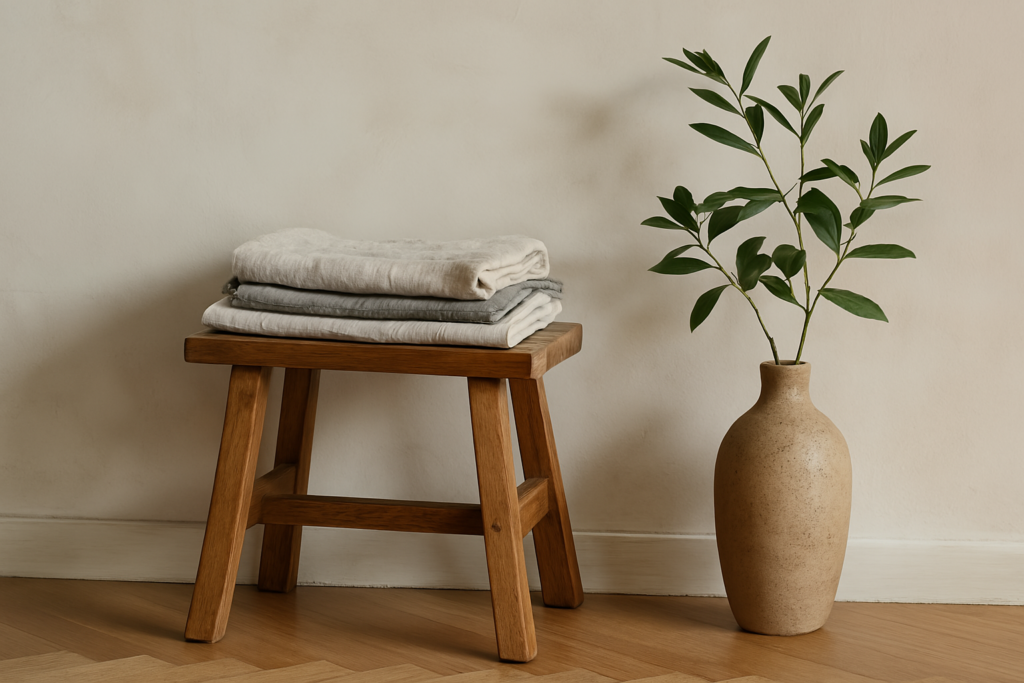Introduction: The Essence of Feel
In the realm of interior design, the significance of sensory experiences is often understated. While visual aesthetics play a crucial role in shaping spaces, the feel of a home profoundly influences our psychological and emotional well-being. Natural textures, in particular, have a unique ability to create an atmosphere that resonates with comfort and tranquility. This connection to materials such as linen, wood, and stone goes beyond mere visuals; it speaks to the soul and enhances the overall experience of a living space.
Natural textures introduce a richness and depth that synthetic materials cannot replicate. For example, the tactile sensation of a soft linen fabric can evoke a sense of calm and relaxation, thereby influencing our moods positively. Similarly, the warmth of wooden surfaces is not only visually appealing but also adds an organic quality that makes a space more inviting. The earthy tones and raw finishes of stone further emphasize this connection to nature, creating a serene environment that grounds us amidst the chaos of modern life.
By purposefully integrating these elements into our homes, we can foster a sense of harmony and well-being. The organic rhythms that result from blending various textures create a unique narrative within our spaces, encouraging us to engage more mindfully with our surroundings. This approach allows individuals to appreciate and be present in their environments, ultimately enhancing their quality of life.
As we explore the impact of natural textures, it becomes evident that their importance extends far beyond aesthetics. Taking the time to recognize and incorporate these materials fosters an appreciation for the subtle yet powerful ways they enrich our lives. By committing to a mindful design approach, we can transform our homes into nurturing sanctuaries that not only please the eye but also elevate our overall experience of living.

Why Texture Matters: The Emotional and Sensory Impact
Texture plays a pivotal role in shaping our emotional and sensory experiences within our environments. The surfaces and materials we choose in our living spaces can significantly influence how we feel and interact with our surroundings. This is particularly true when it comes to designing a home that fosters a sense of safety and nurturing.
Incorporating a balance between rough and soft textures allows for a dynamic interaction within a space. For instance, the coarseness of jute rugs underfoot offers a grounding sensation, inviting individuals to connect with the earth. The tactile engagement with this material can invoke feelings of warmth and comfort, encouraging a slower, more deliberate pace of life. By walking barefoot on jute, one is not just experiencing a surface; rather, they are engaging in a sensory exploration that enhances mindfulness and presence in the moment.

Similarly, the soothing sensation of wood grain provides a rich, natural texture that appeals to our innate desire for connection with nature. The smoothness of polished wood contrasts beautifully with the roughness of other materials, providing harmony within the environment. When fingers glide across the surface of wood, the experience transcends mere aesthetics; it invites a tactile recognition of one’s space, fostering a sense of calm and tranquility.
Furthermore, introducing natural elements into design, such as stone or clay, reinforces this connection to our surroundings. The varied textures of these materials evoke the untamed beauty of the outdoors, serving as a reminder of our place within the natural world. This sensory engagement not only enriches our daily experiences but also nurtures an emotional bond that can enhance our overall well-being. In essence, by thoughtfully integrating diverse textures, we create living spaces that are not only visually appealing but also emotionally resonant.
Common Natural Materials and Their Energies
In the realm of home design, the selection of materials plays a pivotal role in shaping the ambiance and overall aesthetic of a space. Various natural materials carry unique qualities and energies that can influence the feelings evoked within a home. Understanding these materials is essential for making informed design choices. Below are some prevalent natural materials and their corresponding attributes.
Linen, derived from the flax plant, is celebrated for its airy softness. This fabric boasts natural breathability, making it an excellent choice for curtains and upholstery. Linen’s light texture contributes to a sense of openness and tranquility in any room, fostering an inviting atmosphere. Additionally, its ability to regulate temperature enhances comfort, ideal for those warm summer months.
Wool is another material known for its grounding warmth. A staple in textiles, wool has the unique ability to provide insulation, contributing to a cozy environment during colder seasons. Moreover, wool adds a touch of luxury and durability, making it perfect for area rugs and blankets. Its rich, natural fibers resonate with a sense of stability, infusing spaces with a level of comfort and security.
Wood, a timeless natural material, is deeply appreciated for its earthy stability. Each piece of wood boasts its distinct grain, color, and character, allowing for endless design possibilities. Wood brings a warm energy that connects individuals with nature, fostering a calming environment. Its use in furniture, flooring, and accents can transform any space into a serene retreat, encouraging a harmonious relationship with the surroundings.
Lastly, clay is revered for its organic appeal and versatility. Often used in pottery and earthenware, clay adds a tactile quality to interiors and serves as a reminder of nature’s artistry. The warmth of clay, coupled with its handmade nature, provides an authentic touch, inviting creativity and personalization into one’s living space.
By thoughtfully incorporating these natural materials—linen, wool, wood, and clay—homeowners can enhance the energy of their environments, creating spaces that resonate with comfort and harmony.

Choosing Textures for a Breathable Environment
Creating a breathable environment through thoughtfully selected natural textures can significantly enhance the atmosphere of your living space. When considering which textures to integrate into your design, it is important to prioritize materials that resonate with your personal aesthetic while also promoting comfort and tranquility. The tactile nature of natural materials—such as wood, cotton, linen, and stone—provides an inviting quality that draws individuals in, offering both visual appeal and a sense of warmth.
Start by assessing the primary functions of the space and the emotional response you hope to evoke. For instance, softer textures like plush cotton or inviting wool can be particularly effective in areas intended for relaxation, such as a living room. In contrast, harder textures like stone or polished wood can provide a grounding effect in areas that benefit from a sense of stability and strength, such as an entryway or kitchen. Consider mixing various textures to create a layered effect, which adds depth and interest to your surroundings. A combination of sleek, smooth surfaces alongside more tactile, rougher materials can elicit a dynamic and balanced aesthetic.
Furthermore, integrating elements such as woven baskets or wooden decor pieces can enhance the organic feel of your space. These choices foster a connection to nature while encouraging a serene ambiance. It is beneficial to curate textures that not only complement one another but also resonate with your lifestyle. Reflect on how each material makes you feel, as the emotional connection you create with your surroundings is crucial in transforming a house into a true home.
Ultimately, choosing the right mix of natural textures will cultivate an environment that feels both comfortable and inviting, allowing your personal style to shine through in a harmonious way.







